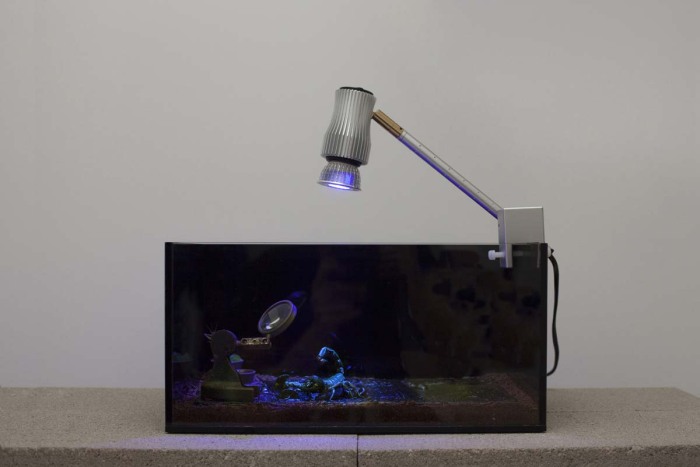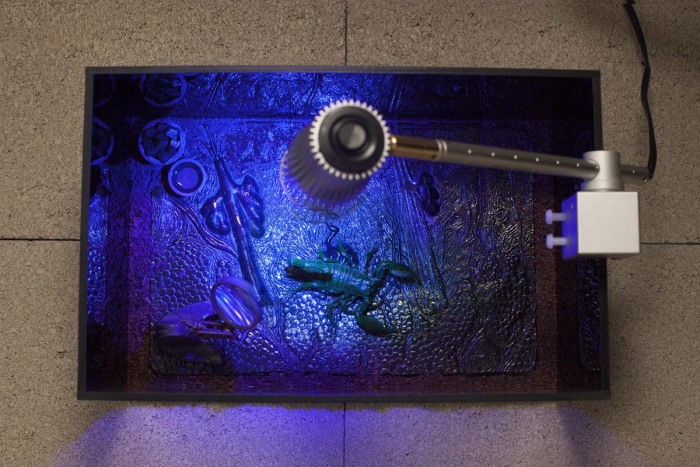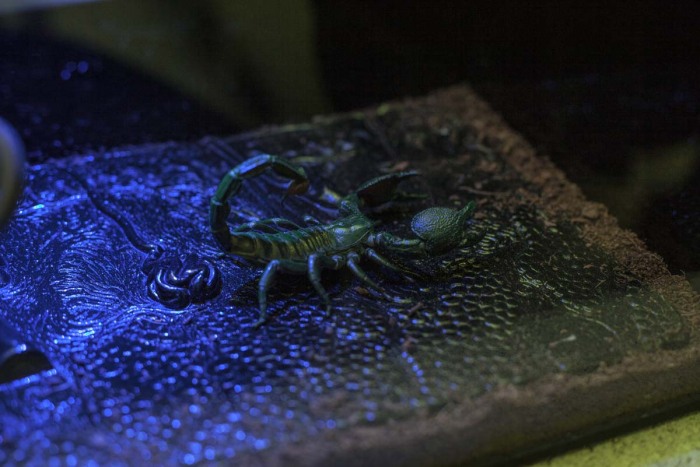Tiempo de lectura: 3 minutos

17.09.2014
Del Vaz Projects, Los Angeles, California, USA
5 de septiembre de 2014 – 22 de noviembre de 2014



“The period we are entering is no longer a period after something: postcommunist, postmodernist, ‘postthis,’ or ‘postthat.’ The present era is ‘proto,’ but a preface
to what, we do not know. Proto- is noncoercive, nonpredictive, and unaccountable: a mode of maybe. The future is a language without grammar, an unconscious without dreams, pure nothing. Inescapably the future becomes everything so as again and again to remain nothing.”
– Transformative Humanities: A Manifesto, Mikhail Epstein
Bathymetry is an attempt to materialize Epstein’s Proto- world through a collection of art- objects that perform as topographies and artifacts for an undefined future, one that is also beyond posthuman and postconsumerist.
Supported by the machinery of technology today, consumption has become such a highly mediated circulation of desires and commodities that it has generated completely new behaviors and circumstances. At the same time, this same machinery of technology has assimilated many functions and specifics previously fulfilled by humans, such as labor, calculation, management, reproduction and even consciousness.
Daniel Keller’s FUBU Career CAPTCHAs foreshadow this – they are hypothetical jobs of the future, created by an algorithm that extracts texts from Bill Joy’s “Why the Future Doesn’t Need Us.” The job description is 3-D printed to resemble CAPTCHAs (Completely Automated Public Turing test to tell Computers and Humans Apart). Spencer Longo exercises an employer-based mechanism, outsourcing the laser engraving of loofahs to three different services. Longo has provided the same motif to each company who subsequently returns with their own interpretations of the same motif, the nuances surfacing in the craftsmanships of each firm.
The works of Liz Craft and Max Hooper Schneider can offer possible landscapes for an indefinite future. Craft’s checkerboard mountains reference the historicity of the classical pattern, which has recently been revived as a “blank slate” for image-editing programs such as Photoshop. The sculpture plays with perception and vision – depending on the observer’s point of view, the sculpture’s contours are either unapologetically pronounced or camouflage completely with the flat surface. Schneider’s dry and wet aquaria are artificial habitats where the agency of matter results in taxonomic confusion. These “post-conflict tide pools” can be seen as documentaries, and complex permutations of organic life and its sensitivity.
Carson Fisk-Vittori addresses organic life and nature through lenses of culture, branding and media. The work hypothesizes on weather modification and future weather trading in the stock market, such that one could choose a torrential storm, a waterfall, artificially seeded snow or your morning shower. Her choice of medium delves into the state of liquid, its gaining value, and its many vessels. Benjamin Phelan’s extruded foam wall relief is an allusion to the waste and pollution that follows mass consumerism. Styrofoam, the protective layer around the coveted goods that provide us with fulfillment, actualization and esteem, is often carelessly discarded and dispersed amongst the landscape.
Natalie Jones’s sculptures and Spencer Ashby’s prototype tripod serve as set-design objects, or props, as to lend theatricality to the installation. Jones’s two sculptures recall a severed swinging caryatid, one half of which is a monument to various popular California citrus fruits. Ashby’s tripod provides the viewer with the liberty to redefine or reify his or her own notions of documenter and documented, bringing aesthetic power to a visually silent object. The viewer is reminded to place him or herself in this set/stage/place that has been created for them to perform in.
With this, Bathymetry intends to provide its viewers with a mode of maybe; a sort of investigation on how the posthuman will navigate and how consumerism will embody itself, if at all, in an era of technological subversion and erosion. Some forms of humanity are sure to disappear because they are transferrable to technological functions but perhaps some are irreducible, and shall be preserved.
Photo Credits: Daniel Sahlberg
Link: http://delvazprojects.com/
Artists : Daniel Keller, Liz Craft, Carson Fisk-Vittori, Natalie Jones, Spencer Ashby, Spencer Longo, Benjamin Phelan, Max Hooper Schneider
Comentarios
No hay comentarios disponibles.